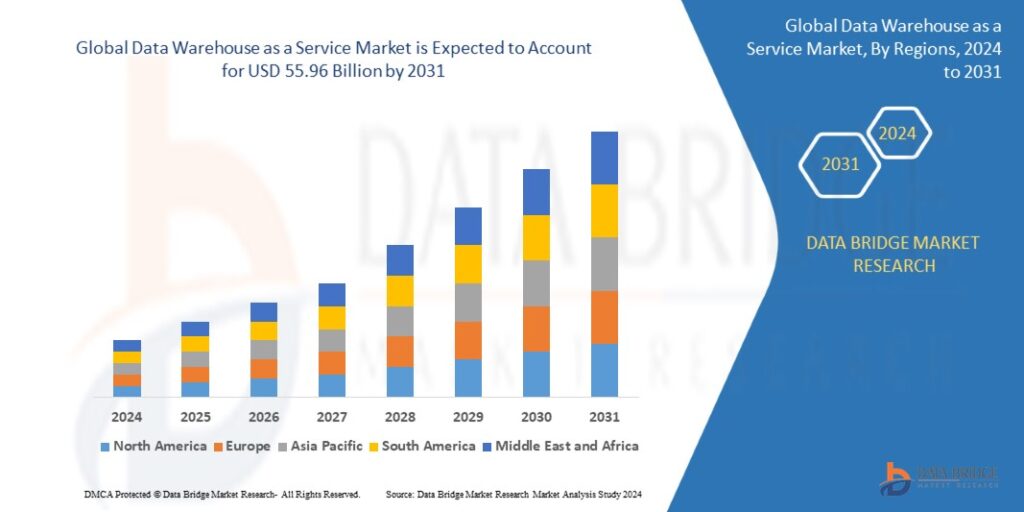Introduction
In the age of data-driven decision-making, businesses across industries rely heavily on data analytics to gain insights, forecast trends, and drive strategic initiatives. However, with the explosion of data from various sources, managing and processing this data efficiently has become a complex task. Traditional data warehouses, though effective, often struggle to keep up with the demands of modern data analytics due to high costs, maintenance complexities, and scalability limitations. Enter Data Warehouse as a Service (DWaaS)—a cloud-based solution that is reshaping the landscape of data analytics by offering flexibility, scalability, and efficiency. We will explore how DWaaS is transforming data analytics and empowering businesses to make faster, data-driven decisions.
Definition
Data Warehouse as a Service (DWaaS) is a cloud-based service paradigm that enables businesses to handle, store, and analyse massive amounts of data without requiring on-premises hardware. With flexibility and cost-effectiveness, DWaaS enables companies to increase their data warehousing capabilities in response to demand. It usually has features that let users quickly learn from their data, like data integration, automated backups, and sophisticated analytics tools. Businesses can use DWaaS to boost operational efficiency and speed up decision-making by concentrating on data analysis rather than infrastructure administration.
What is Data Warehouse as a Service (DWaaS)?
Data Warehouse as a Service (DWaaS) is a managed cloud service that allows businesses to store, process, and analyze large volumes of data without the need for on-premises infrastructure. DWaaS providers, such as Amazon Redshift, Google BigQuery, and Snowflake, host and manage data warehouses in their cloud environments, handling everything from infrastructure maintenance to software updates. DWaaS is built to scale on-demand, offering flexible pricing models, and allowing businesses to pay only for the resources they use.
Unlike traditional data warehouses that require extensive setup, maintenance, and upgrading, DWaaS platforms eliminate the need for physical hardware, allowing companies to focus on extracting insights from their data rather than managing infrastructure. This shift to a cloud-based solution enables businesses to enhance their data analytics capabilities with ease and cost-efficiency.
The Key Benefits of DWaaS in Data Analytics
Scalability and Flexibility:
Traditional data warehouses can be challenging to scale, often requiring significant investment in additional hardware and software. DWaaS, on the other hand, is inherently scalable. Businesses can begin with very little resources and increase as their data requirements increase. This flexibility allows organizations to handle varying workloads and optimize their data storage costs. DWaaS platforms offer both horizontal and vertical scalability, ensuring that companies can quickly adapt to changing data demands and stay competitive.
Cost-Effectiveness:
Building and maintaining a traditional data warehouse is expensive, requiring significant upfront capital for hardware, licensing fees, and skilled personnel. DWaaS operates on a pay-as-you-go model, allowing organizations to avoid hefty capital expenditures. DWaaS is an affordable choice for companies of all sizes because they only pay for the computing and storage resources they utilise. Additionally, with cloud providers handling maintenance, upgrades, and security, operational costs are significantly reduced.
Simplified Data Management:
DWaaS providers take over data management tasks, such as database tuning, patching, and backup, freeing up IT teams to focus on more strategic tasks. This reduces the workload for in-house teams and allows data scientists, analysts, and business intelligence professionals to spend more time analyzing data and less time managing infrastructure. DWaaS automates many of these management processes, improving efficiency and reducing the chance of human error.
Faster Time-to-Insights:
With DWaaS, data processing is faster and more efficient. Companies can ingest, store, and analyze data at unprecedented speeds, enabling real-time or near-real-time analytics. This rapid access to insights allows businesses to respond more quickly to market changes and consumer trends. Many DWaaS solutions also integrate with advanced analytics tools, enabling businesses to leverage machine learning, artificial intelligence, and predictive analytics to gain deeper insights.
Enhanced Data Security and Compliance:
Security and compliance are crucial for data management, especially with regulations like GDPR, CCPA, and HIPAA imposing strict standards on data handling. DWaaS providers prioritize data security with multi-layered encryption, role-based access controls, and regular audits. Leading DWaaS platforms comply with various industry standards and regulations, helping businesses meet their compliance requirements and protect sensitive data. By entrusting data security to reputable cloud providers, companies can ensure their data is safe while avoiding the costs associated with building and maintaining secure on-premises infrastructure.
Seamless Integration with BI Tools:
DWaaS platforms support integration with a wide range of business intelligence (BI) and data analytics tools, allowing businesses to use their preferred software. Whether it’s Tableau, Power BI, or custom analytics applications, DWaaS provides compatibility and often comes with connectors that simplify the data extraction process. This interoperability enables seamless data analysis, visualization, and reporting, providing business teams with comprehensive insights that drive informed decision-making.
How DWaaS is Reshaping the Data Analytics Landscape
Breaking Down Data Silos:
In traditional setups, data is often siloed across various departments or applications, making it challenging to gain a holistic view of the business. DWaaS centralizes data from multiple sources, breaking down these silos and enabling organizations to unify their data. With all information stored in a single location, companies can achieve a 360-degree view of their data, leading to more accurate analytics and better decision-making.
Enabling Advanced Analytics and AI Applications:
DWaaS platforms provide the computational power required for advanced analytics and artificial intelligence. By leveraging cloud-based resources, companies can run machine learning algorithms, natural language processing, and complex data modeling without performance issues. DWaaS enables businesses to conduct predictive and prescriptive analytics, which helps identify trends, forecast future outcomes, and create actionable insights that drive strategy.
Improving Data Accessibility Across the Organization:
The potential of DWaaS to democratise data access is one of its revolutionary features. With traditional data warehouses, only IT and data teams could easily access and manipulate data. DWaaS changes this by providing intuitive, user-friendly interfaces that allow business users across departments to access and analyze data independently. This self-service model reduces bottlenecks and empowers non-technical employees to make data-driven decisions, boosting overall productivity.
Supporting Real-Time Decision-Making:
DWaaS platforms enable real-time data processing and analytics, which is essential for businesses operating in fast-paced environments. From retail and finance to healthcare, many industries benefit from real-time insights that enable agile responses to market dynamics. DWaaS allows companies to quickly ingest and analyze live data streams, providing up-to-the-minute insights that support instant decision-making and proactive problem-solving.
Challenges and Considerations in DWaaS Adoption
While DWaaS offers numerous benefits, there are considerations to address:
Data Governance and Quality Control:
Ensuring high data quality and governance is crucial in a DWaaS environment. With multiple sources feeding into a central data warehouse, inconsistencies and inaccuracies may arise. Businesses need to implement data governance frameworks that ensure data is accurate, consistent, and reliable. Additionally, it’s important to establish protocols for data validation and cleansing.
Managing Costs in Large-Scale Deployments:
Although DWaaS operates on a pay-as-you-go model, costs can escalate with increased data volume and processing demands. It’s essential to monitor usage and implement cost management strategies, such as data archiving, resource allocation, and optimization of query performance. Many DWaaS providers offer tools to help businesses monitor and control their expenses.
Data Security and Privacy Concerns:
Storing sensitive data in the cloud can raise security and privacy concerns, particularly in highly regulated industries. Businesses need to work with DWaaS providers that adhere to strict security standards and comply with industry regulations. Implementing additional security measures, such as data encryption, role-based access control, and regular audits, can further enhance data security.
Data Warehouse as a Service Market Growth Rate
With a compound annual growth rate (CAGR) of 25.55% from 2024 to 2031, the worldwide data warehouse as a service market is expected to grow from its 2023 valuation of USD 9.06 billion to USD 55.96 billion by 2031.
Read More: https://www.databridgemarketresearch.com/reports/global-data-warehouse-as-a-service-market
Conclusion
Data Warehouse as a Service is revolutionizing data analytics by providing scalable, cost-effective, and high-performance solutions for storing and analyzing data. By shifting to DWaaS, businesses can overcome the limitations of traditional data warehouses and unlock the full potential of their data. With features such as advanced analytics, real-time processing, and seamless BI integration, DWaaS empowers organizations to make data-driven decisions with confidence and agility.



